BSc Business Management (BMP3002): Company Types and Factors
VerifiedAdded on 2022/12/23
|9
|2554
|73
Report
AI Summary
This report, submitted for the BSc (Hons) Business Management with Foundation course (BMP3002), explores diverse types of companies, including micro, small, medium, and large businesses, along with sole traders, partnerships, limited liability companies, public limited companies, and cooperatives. The report delves into different organizational structures, such as divisional and functional, and their impact on business productivity. Furthermore, it examines external factors affecting business performance through a PESTLE analysis, considering political, economic, social, technological, environmental, and legal factors, with a case study on ASDA. The report concludes by emphasizing the importance of selecting the appropriate business structure and understanding external influences for successful business operations.
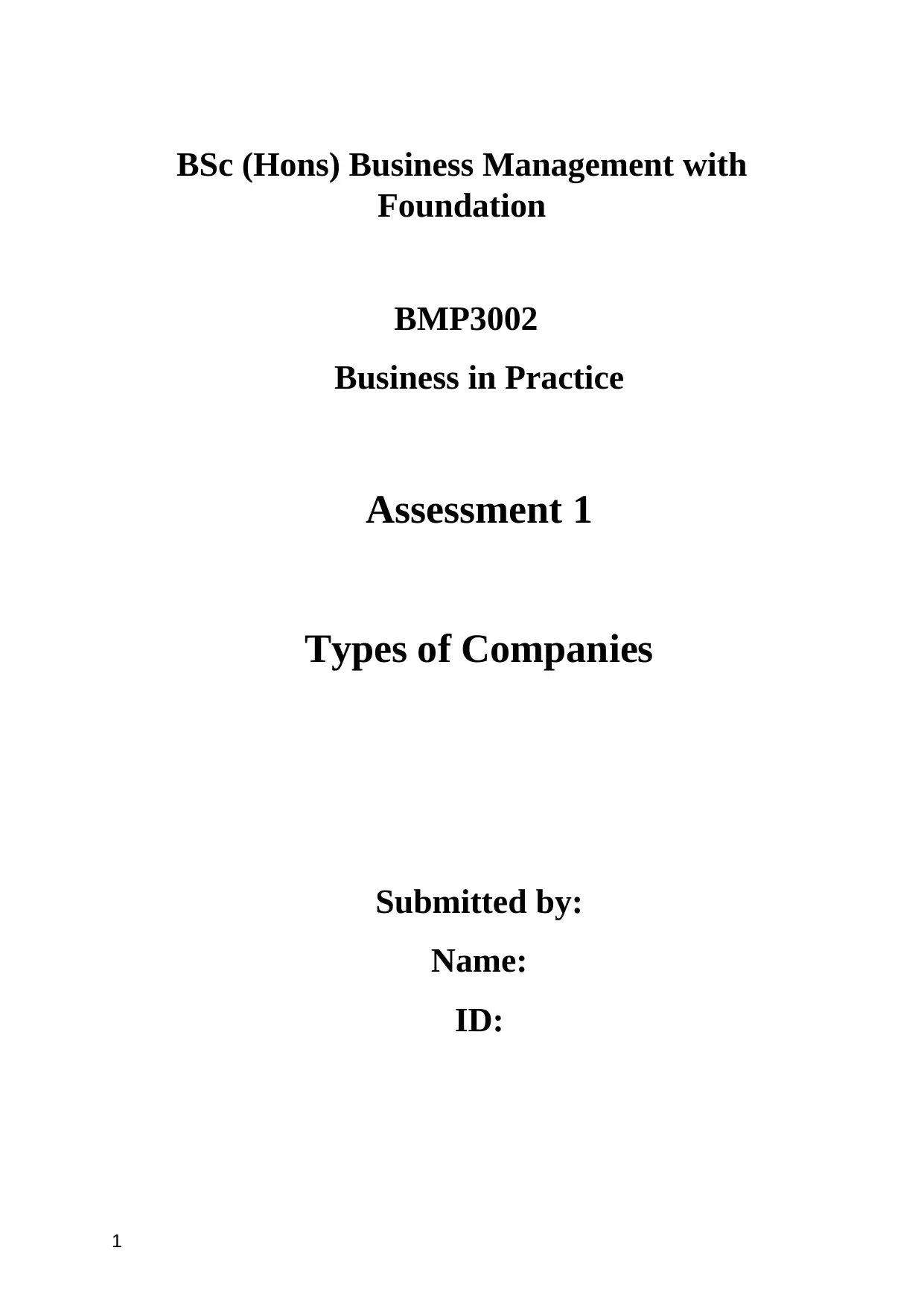
BSc (Hons) Business Management with
Foundation
BMP3002
Business in Practice
Assessment 1
Types of Companies
Submitted by:
Name:
ID:
1
Foundation
BMP3002
Business in Practice
Assessment 1
Types of Companies
Submitted by:
Name:
ID:
1
Paraphrase This Document
Need a fresh take? Get an instant paraphrase of this document with our AI Paraphraser
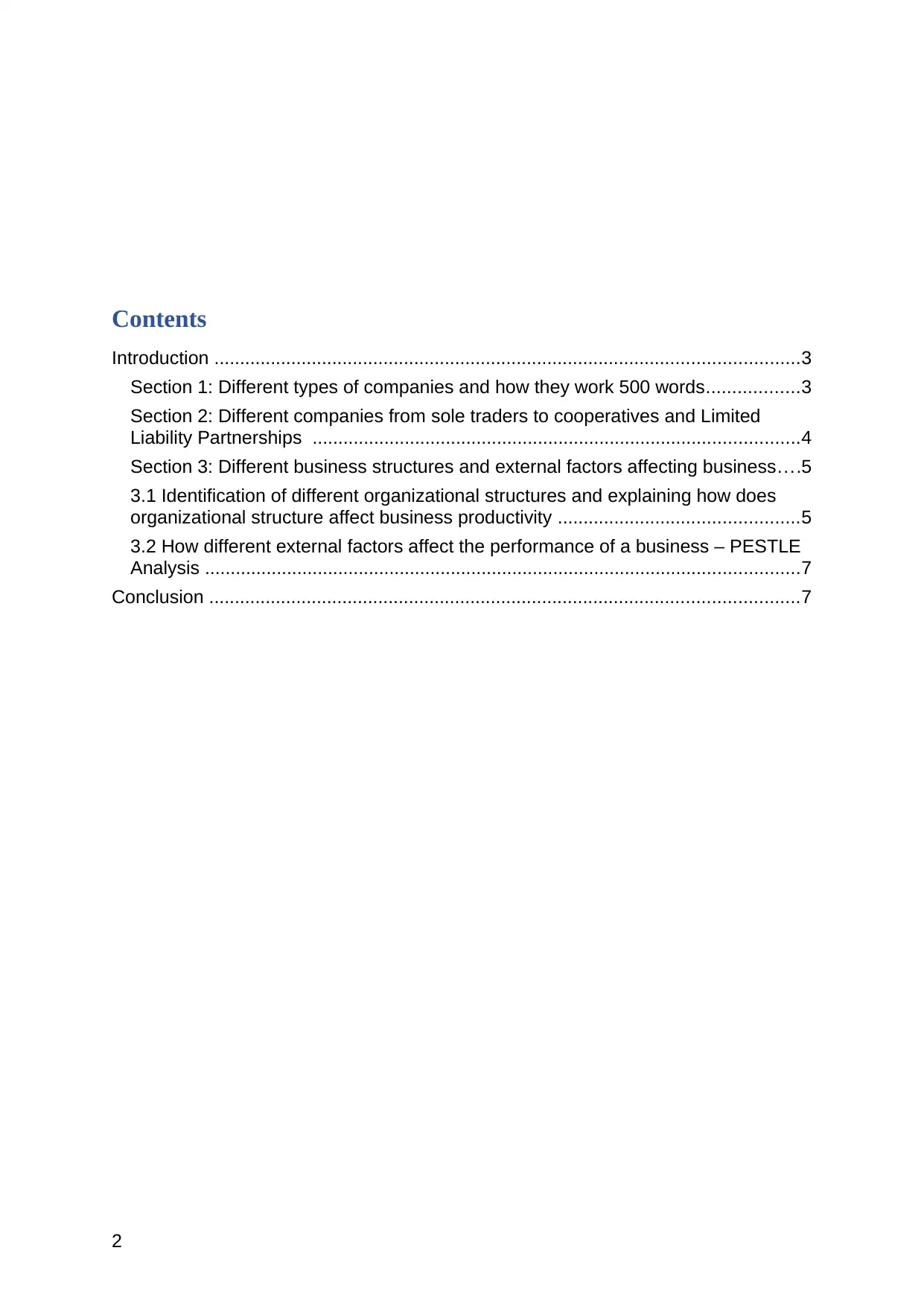
Contents
Introduction ..................................................................................................................3
Section 1: Different types of companies and how they work 500 words..................3
Section 2: Different companies from sole traders to cooperatives and Limited
Liability Partnerships ...............................................................................................4
Section 3: Different business structures and external factors affecting business....5
3.1 Identification of different organizational structures and explaining how does
organizational structure affect business productivity ...............................................5
3.2 How different external factors affect the performance of a business – PESTLE
Analysis ....................................................................................................................7
Conclusion ...................................................................................................................7
2
Introduction ..................................................................................................................3
Section 1: Different types of companies and how they work 500 words..................3
Section 2: Different companies from sole traders to cooperatives and Limited
Liability Partnerships ...............................................................................................4
Section 3: Different business structures and external factors affecting business....5
3.1 Identification of different organizational structures and explaining how does
organizational structure affect business productivity ...............................................5
3.2 How different external factors affect the performance of a business – PESTLE
Analysis ....................................................................................................................7
Conclusion ...................................................................................................................7
2
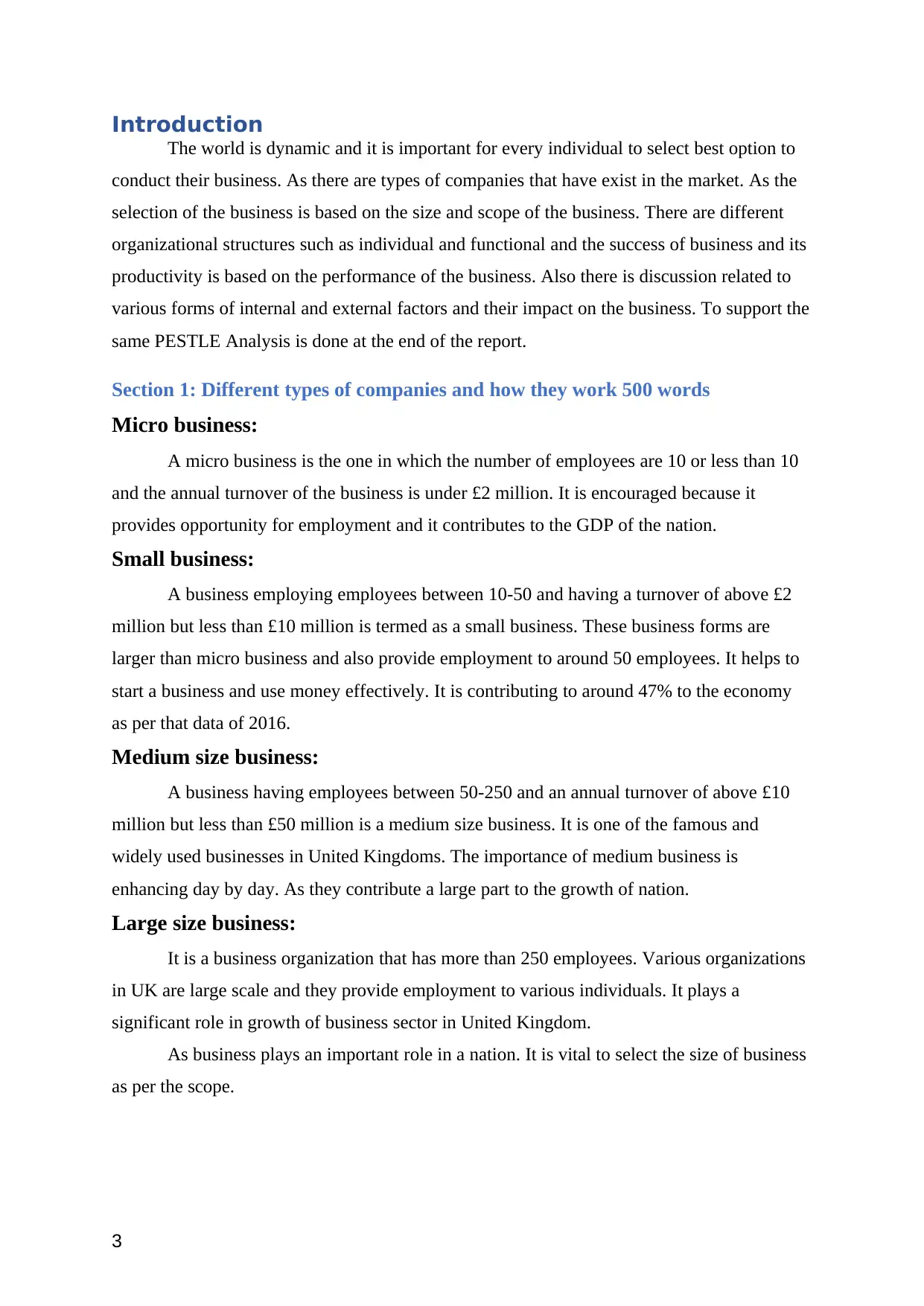
Introduction
The world is dynamic and it is important for every individual to select best option to
conduct their business. As there are types of companies that have exist in the market. As the
selection of the business is based on the size and scope of the business. There are different
organizational structures such as individual and functional and the success of business and its
productivity is based on the performance of the business. Also there is discussion related to
various forms of internal and external factors and their impact on the business. To support the
same PESTLE Analysis is done at the end of the report.
Section 1: Different types of companies and how they work 500 words
Micro business:
A micro business is the one in which the number of employees are 10 or less than 10
and the annual turnover of the business is under £2 million. It is encouraged because it
provides opportunity for employment and it contributes to the GDP of the nation.
Small business:
A business employing employees between 10-50 and having a turnover of above £2
million but less than £10 million is termed as a small business. These business forms are
larger than micro business and also provide employment to around 50 employees. It helps to
start a business and use money effectively. It is contributing to around 47% to the economy
as per that data of 2016.
Medium size business:
A business having employees between 50-250 and an annual turnover of above £10
million but less than £50 million is a medium size business. It is one of the famous and
widely used businesses in United Kingdoms. The importance of medium business is
enhancing day by day. As they contribute a large part to the growth of nation.
Large size business:
It is a business organization that has more than 250 employees. Various organizations
in UK are large scale and they provide employment to various individuals. It plays a
significant role in growth of business sector in United Kingdom.
As business plays an important role in a nation. It is vital to select the size of business
as per the scope.
3
The world is dynamic and it is important for every individual to select best option to
conduct their business. As there are types of companies that have exist in the market. As the
selection of the business is based on the size and scope of the business. There are different
organizational structures such as individual and functional and the success of business and its
productivity is based on the performance of the business. Also there is discussion related to
various forms of internal and external factors and their impact on the business. To support the
same PESTLE Analysis is done at the end of the report.
Section 1: Different types of companies and how they work 500 words
Micro business:
A micro business is the one in which the number of employees are 10 or less than 10
and the annual turnover of the business is under £2 million. It is encouraged because it
provides opportunity for employment and it contributes to the GDP of the nation.
Small business:
A business employing employees between 10-50 and having a turnover of above £2
million but less than £10 million is termed as a small business. These business forms are
larger than micro business and also provide employment to around 50 employees. It helps to
start a business and use money effectively. It is contributing to around 47% to the economy
as per that data of 2016.
Medium size business:
A business having employees between 50-250 and an annual turnover of above £10
million but less than £50 million is a medium size business. It is one of the famous and
widely used businesses in United Kingdoms. The importance of medium business is
enhancing day by day. As they contribute a large part to the growth of nation.
Large size business:
It is a business organization that has more than 250 employees. Various organizations
in UK are large scale and they provide employment to various individuals. It plays a
significant role in growth of business sector in United Kingdom.
As business plays an important role in a nation. It is vital to select the size of business
as per the scope.
3
⊘ This is a preview!⊘
Do you want full access?
Subscribe today to unlock all pages.

Trusted by 1+ million students worldwide
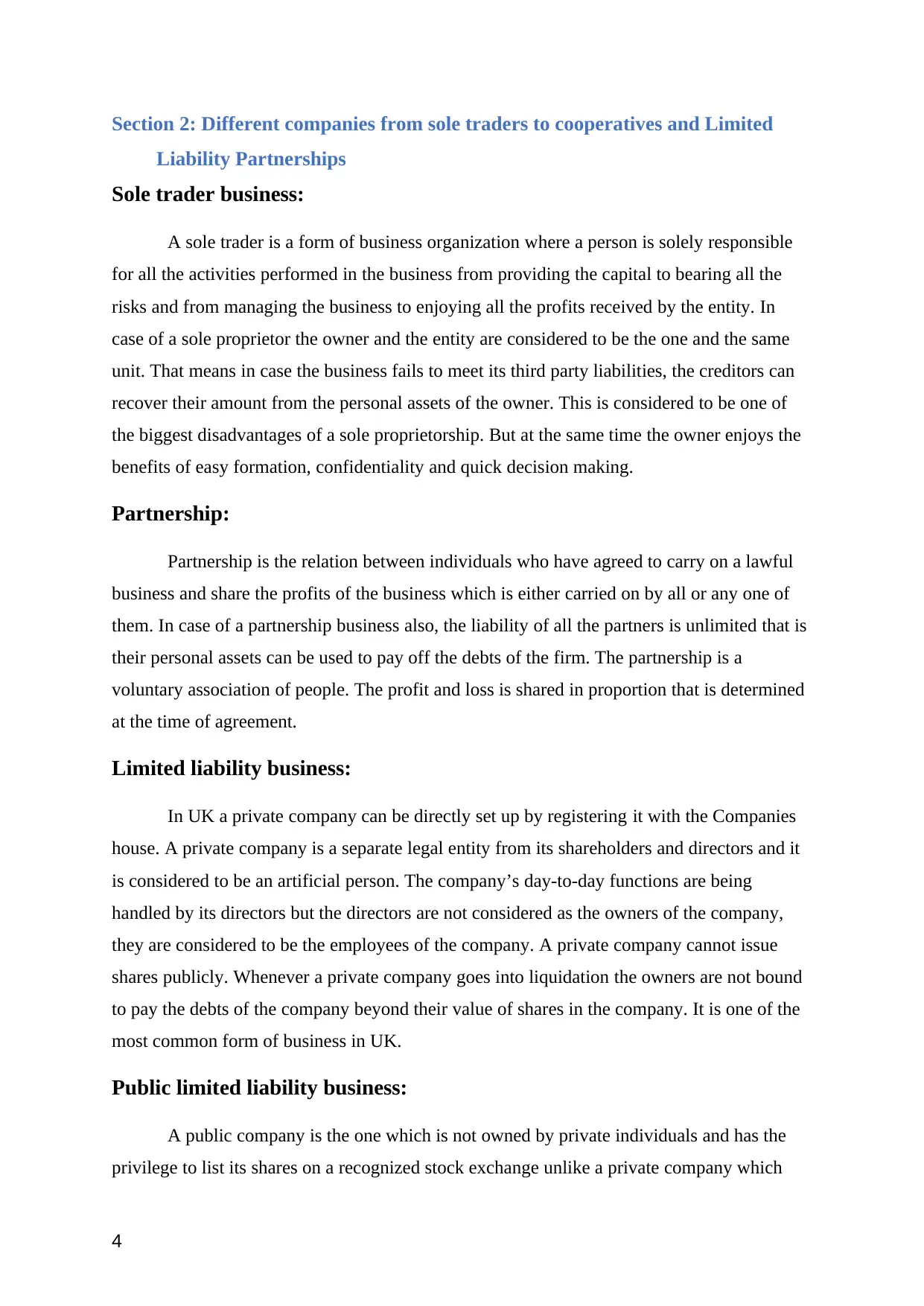
Section 2: Different companies from sole traders to cooperatives and Limited
Liability Partnerships
Sole trader business:
A sole trader is a form of business organization where a person is solely responsible
for all the activities performed in the business from providing the capital to bearing all the
risks and from managing the business to enjoying all the profits received by the entity. In
case of a sole proprietor the owner and the entity are considered to be the one and the same
unit. That means in case the business fails to meet its third party liabilities, the creditors can
recover their amount from the personal assets of the owner. This is considered to be one of
the biggest disadvantages of a sole proprietorship. But at the same time the owner enjoys the
benefits of easy formation, confidentiality and quick decision making.
Partnership:
Partnership is the relation between individuals who have agreed to carry on a lawful
business and share the profits of the business which is either carried on by all or any one of
them. In case of a partnership business also, the liability of all the partners is unlimited that is
their personal assets can be used to pay off the debts of the firm. The partnership is a
voluntary association of people. The profit and loss is shared in proportion that is determined
at the time of agreement.
Limited liability business:
In UK a private company can be directly set up by registering it with the Companies
house. A private company is a separate legal entity from its shareholders and directors and it
is considered to be an artificial person. The company’s day-to-day functions are being
handled by its directors but the directors are not considered as the owners of the company,
they are considered to be the employees of the company. A private company cannot issue
shares publicly. Whenever a private company goes into liquidation the owners are not bound
to pay the debts of the company beyond their value of shares in the company. It is one of the
most common form of business in UK.
Public limited liability business:
A public company is the one which is not owned by private individuals and has the
privilege to list its shares on a recognized stock exchange unlike a private company which
4
Liability Partnerships
Sole trader business:
A sole trader is a form of business organization where a person is solely responsible
for all the activities performed in the business from providing the capital to bearing all the
risks and from managing the business to enjoying all the profits received by the entity. In
case of a sole proprietor the owner and the entity are considered to be the one and the same
unit. That means in case the business fails to meet its third party liabilities, the creditors can
recover their amount from the personal assets of the owner. This is considered to be one of
the biggest disadvantages of a sole proprietorship. But at the same time the owner enjoys the
benefits of easy formation, confidentiality and quick decision making.
Partnership:
Partnership is the relation between individuals who have agreed to carry on a lawful
business and share the profits of the business which is either carried on by all or any one of
them. In case of a partnership business also, the liability of all the partners is unlimited that is
their personal assets can be used to pay off the debts of the firm. The partnership is a
voluntary association of people. The profit and loss is shared in proportion that is determined
at the time of agreement.
Limited liability business:
In UK a private company can be directly set up by registering it with the Companies
house. A private company is a separate legal entity from its shareholders and directors and it
is considered to be an artificial person. The company’s day-to-day functions are being
handled by its directors but the directors are not considered as the owners of the company,
they are considered to be the employees of the company. A private company cannot issue
shares publicly. Whenever a private company goes into liquidation the owners are not bound
to pay the debts of the company beyond their value of shares in the company. It is one of the
most common form of business in UK.
Public limited liability business:
A public company is the one which is not owned by private individuals and has the
privilege to list its shares on a recognized stock exchange unlike a private company which
4
Paraphrase This Document
Need a fresh take? Get an instant paraphrase of this document with our AI Paraphraser
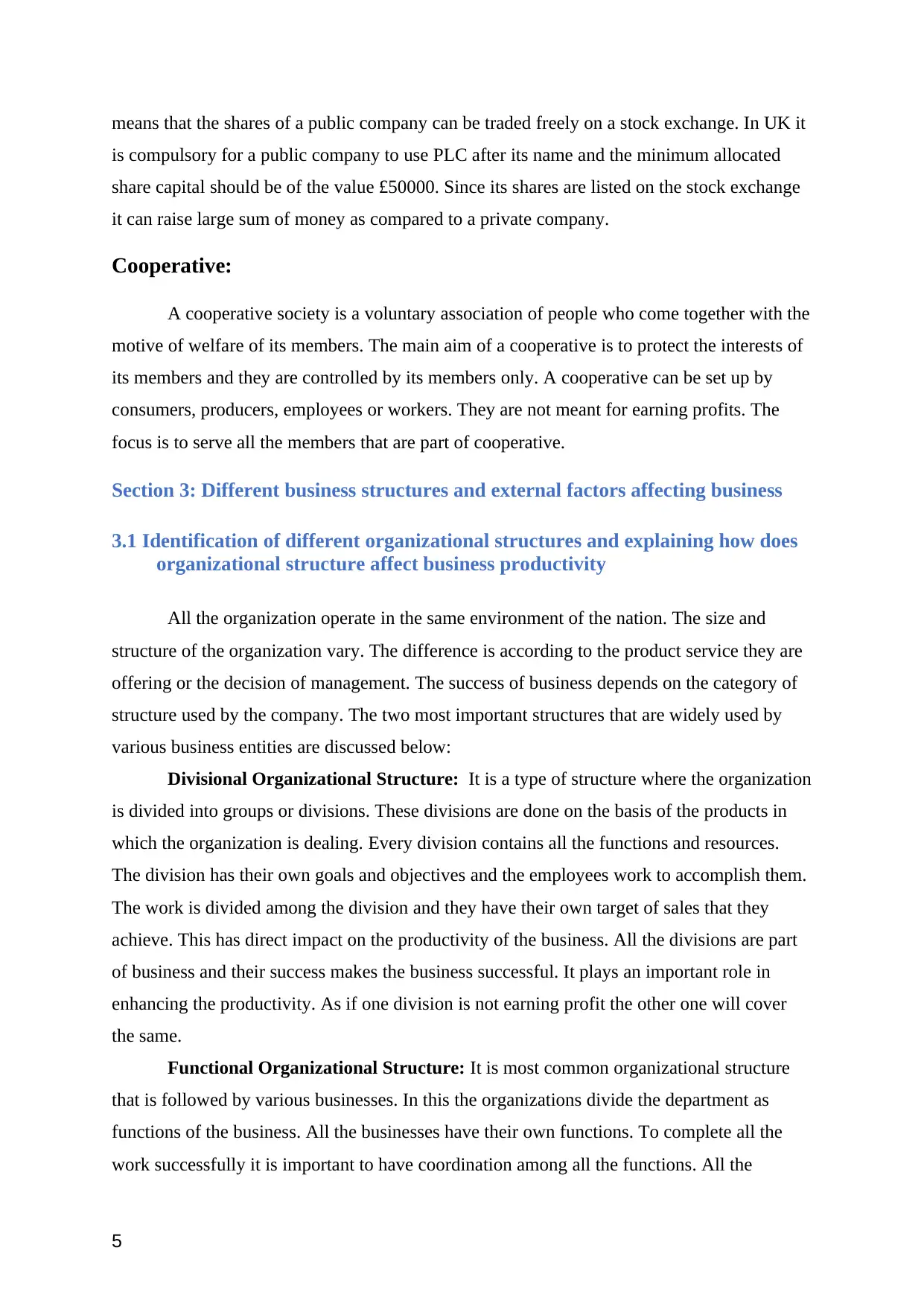
means that the shares of a public company can be traded freely on a stock exchange. In UK it
is compulsory for a public company to use PLC after its name and the minimum allocated
share capital should be of the value £50000. Since its shares are listed on the stock exchange
it can raise large sum of money as compared to a private company.
Cooperative:
A cooperative society is a voluntary association of people who come together with the
motive of welfare of its members. The main aim of a cooperative is to protect the interests of
its members and they are controlled by its members only. A cooperative can be set up by
consumers, producers, employees or workers. They are not meant for earning profits. The
focus is to serve all the members that are part of cooperative.
Section 3: Different business structures and external factors affecting business
3.1 Identification of different organizational structures and explaining how does
organizational structure affect business productivity
All the organization operate in the same environment of the nation. The size and
structure of the organization vary. The difference is according to the product service they are
offering or the decision of management. The success of business depends on the category of
structure used by the company. The two most important structures that are widely used by
various business entities are discussed below:
Divisional Organizational Structure: It is a type of structure where the organization
is divided into groups or divisions. These divisions are done on the basis of the products in
which the organization is dealing. Every division contains all the functions and resources.
The division has their own goals and objectives and the employees work to accomplish them.
The work is divided among the division and they have their own target of sales that they
achieve. This has direct impact on the productivity of the business. All the divisions are part
of business and their success makes the business successful. It plays an important role in
enhancing the productivity. As if one division is not earning profit the other one will cover
the same.
Functional Organizational Structure: It is most common organizational structure
that is followed by various businesses. In this the organizations divide the department as
functions of the business. All the businesses have their own functions. To complete all the
work successfully it is important to have coordination among all the functions. All the
5
is compulsory for a public company to use PLC after its name and the minimum allocated
share capital should be of the value £50000. Since its shares are listed on the stock exchange
it can raise large sum of money as compared to a private company.
Cooperative:
A cooperative society is a voluntary association of people who come together with the
motive of welfare of its members. The main aim of a cooperative is to protect the interests of
its members and they are controlled by its members only. A cooperative can be set up by
consumers, producers, employees or workers. They are not meant for earning profits. The
focus is to serve all the members that are part of cooperative.
Section 3: Different business structures and external factors affecting business
3.1 Identification of different organizational structures and explaining how does
organizational structure affect business productivity
All the organization operate in the same environment of the nation. The size and
structure of the organization vary. The difference is according to the product service they are
offering or the decision of management. The success of business depends on the category of
structure used by the company. The two most important structures that are widely used by
various business entities are discussed below:
Divisional Organizational Structure: It is a type of structure where the organization
is divided into groups or divisions. These divisions are done on the basis of the products in
which the organization is dealing. Every division contains all the functions and resources.
The division has their own goals and objectives and the employees work to accomplish them.
The work is divided among the division and they have their own target of sales that they
achieve. This has direct impact on the productivity of the business. All the divisions are part
of business and their success makes the business successful. It plays an important role in
enhancing the productivity. As if one division is not earning profit the other one will cover
the same.
Functional Organizational Structure: It is most common organizational structure
that is followed by various businesses. In this the organizations divide the department as
functions of the business. All the businesses have their own functions. To complete all the
work successfully it is important to have coordination among all the functions. All the
5
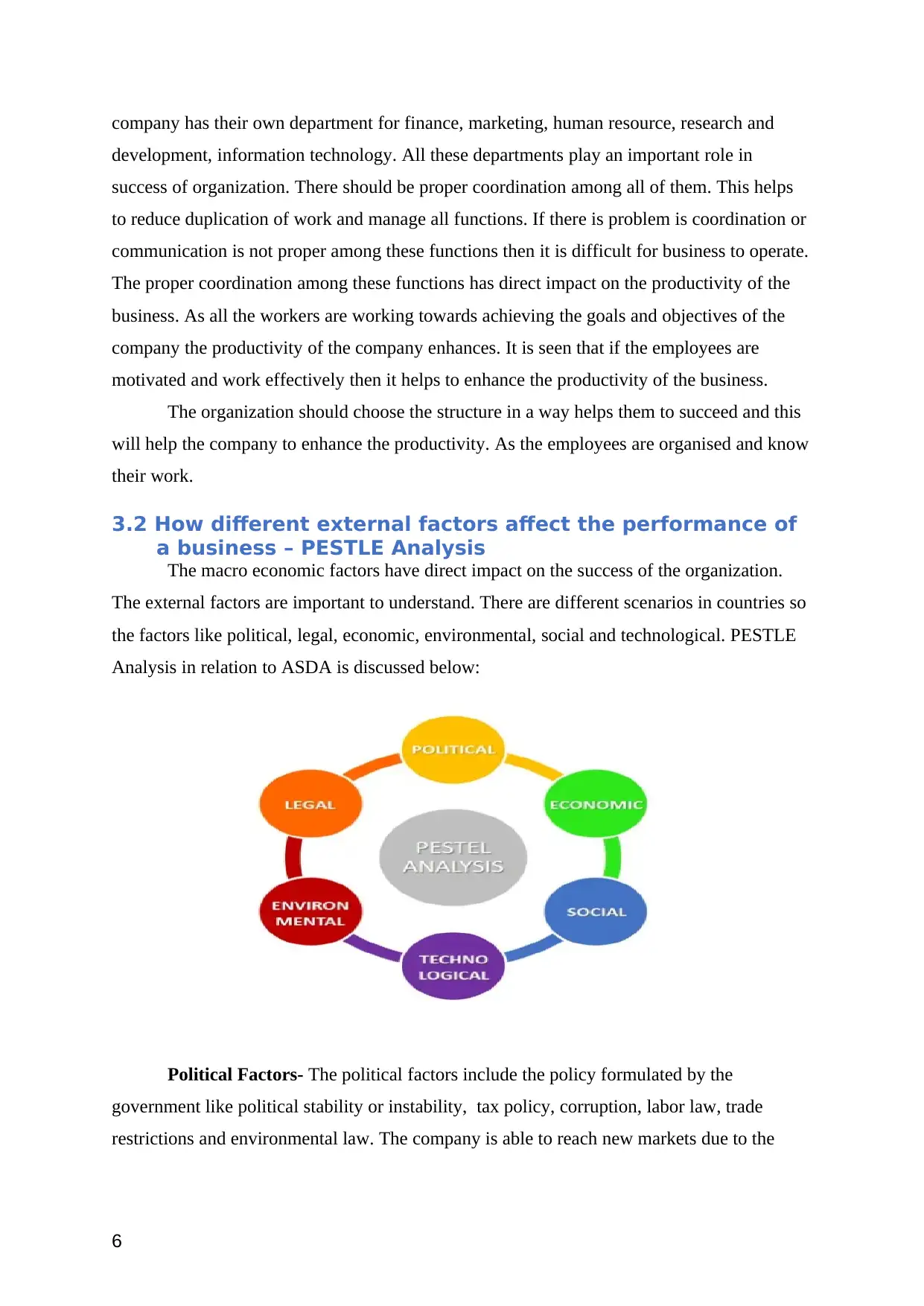
company has their own department for finance, marketing, human resource, research and
development, information technology. All these departments play an important role in
success of organization. There should be proper coordination among all of them. This helps
to reduce duplication of work and manage all functions. If there is problem is coordination or
communication is not proper among these functions then it is difficult for business to operate.
The proper coordination among these functions has direct impact on the productivity of the
business. As all the workers are working towards achieving the goals and objectives of the
company the productivity of the company enhances. It is seen that if the employees are
motivated and work effectively then it helps to enhance the productivity of the business.
The organization should choose the structure in a way helps them to succeed and this
will help the company to enhance the productivity. As the employees are organised and know
their work.
3.2 How different external factors affect the performance of
a business – PESTLE Analysis
The macro economic factors have direct impact on the success of the organization.
The external factors are important to understand. There are different scenarios in countries so
the factors like political, legal, economic, environmental, social and technological. PESTLE
Analysis in relation to ASDA is discussed below:
Political Factors- The political factors include the policy formulated by the
government like political stability or instability, tax policy, corruption, labor law, trade
restrictions and environmental law. The company is able to reach new markets due to the
6
development, information technology. All these departments play an important role in
success of organization. There should be proper coordination among all of them. This helps
to reduce duplication of work and manage all functions. If there is problem is coordination or
communication is not proper among these functions then it is difficult for business to operate.
The proper coordination among these functions has direct impact on the productivity of the
business. As all the workers are working towards achieving the goals and objectives of the
company the productivity of the company enhances. It is seen that if the employees are
motivated and work effectively then it helps to enhance the productivity of the business.
The organization should choose the structure in a way helps them to succeed and this
will help the company to enhance the productivity. As the employees are organised and know
their work.
3.2 How different external factors affect the performance of
a business – PESTLE Analysis
The macro economic factors have direct impact on the success of the organization.
The external factors are important to understand. There are different scenarios in countries so
the factors like political, legal, economic, environmental, social and technological. PESTLE
Analysis in relation to ASDA is discussed below:
Political Factors- The political factors include the policy formulated by the
government like political stability or instability, tax policy, corruption, labor law, trade
restrictions and environmental law. The company is able to reach new markets due to the
6
⊘ This is a preview!⊘
Do you want full access?
Subscribe today to unlock all pages.

Trusted by 1+ million students worldwide
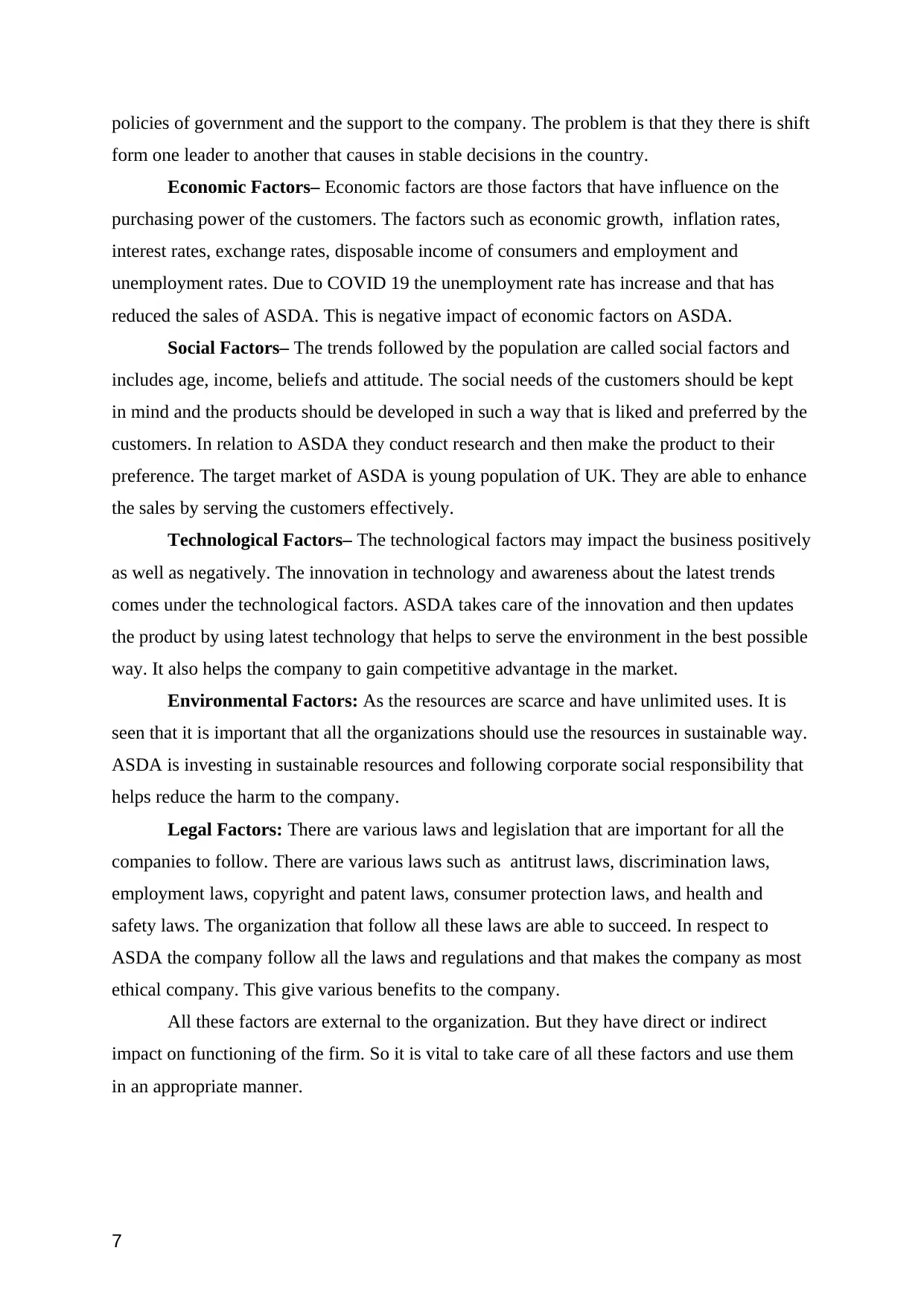
policies of government and the support to the company. The problem is that they there is shift
form one leader to another that causes in stable decisions in the country.
Economic Factors– Economic factors are those factors that have influence on the
purchasing power of the customers. The factors such as economic growth, inflation rates,
interest rates, exchange rates, disposable income of consumers and employment and
unemployment rates. Due to COVID 19 the unemployment rate has increase and that has
reduced the sales of ASDA. This is negative impact of economic factors on ASDA.
Social Factors– The trends followed by the population are called social factors and
includes age, income, beliefs and attitude. The social needs of the customers should be kept
in mind and the products should be developed in such a way that is liked and preferred by the
customers. In relation to ASDA they conduct research and then make the product to their
preference. The target market of ASDA is young population of UK. They are able to enhance
the sales by serving the customers effectively.
Technological Factors– The technological factors may impact the business positively
as well as negatively. The innovation in technology and awareness about the latest trends
comes under the technological factors. ASDA takes care of the innovation and then updates
the product by using latest technology that helps to serve the environment in the best possible
way. It also helps the company to gain competitive advantage in the market.
Environmental Factors: As the resources are scarce and have unlimited uses. It is
seen that it is important that all the organizations should use the resources in sustainable way.
ASDA is investing in sustainable resources and following corporate social responsibility that
helps reduce the harm to the company.
Legal Factors: There are various laws and legislation that are important for all the
companies to follow. There are various laws such as antitrust laws, discrimination laws,
employment laws, copyright and patent laws, consumer protection laws, and health and
safety laws. The organization that follow all these laws are able to succeed. In respect to
ASDA the company follow all the laws and regulations and that makes the company as most
ethical company. This give various benefits to the company.
All these factors are external to the organization. But they have direct or indirect
impact on functioning of the firm. So it is vital to take care of all these factors and use them
in an appropriate manner.
7
form one leader to another that causes in stable decisions in the country.
Economic Factors– Economic factors are those factors that have influence on the
purchasing power of the customers. The factors such as economic growth, inflation rates,
interest rates, exchange rates, disposable income of consumers and employment and
unemployment rates. Due to COVID 19 the unemployment rate has increase and that has
reduced the sales of ASDA. This is negative impact of economic factors on ASDA.
Social Factors– The trends followed by the population are called social factors and
includes age, income, beliefs and attitude. The social needs of the customers should be kept
in mind and the products should be developed in such a way that is liked and preferred by the
customers. In relation to ASDA they conduct research and then make the product to their
preference. The target market of ASDA is young population of UK. They are able to enhance
the sales by serving the customers effectively.
Technological Factors– The technological factors may impact the business positively
as well as negatively. The innovation in technology and awareness about the latest trends
comes under the technological factors. ASDA takes care of the innovation and then updates
the product by using latest technology that helps to serve the environment in the best possible
way. It also helps the company to gain competitive advantage in the market.
Environmental Factors: As the resources are scarce and have unlimited uses. It is
seen that it is important that all the organizations should use the resources in sustainable way.
ASDA is investing in sustainable resources and following corporate social responsibility that
helps reduce the harm to the company.
Legal Factors: There are various laws and legislation that are important for all the
companies to follow. There are various laws such as antitrust laws, discrimination laws,
employment laws, copyright and patent laws, consumer protection laws, and health and
safety laws. The organization that follow all these laws are able to succeed. In respect to
ASDA the company follow all the laws and regulations and that makes the company as most
ethical company. This give various benefits to the company.
All these factors are external to the organization. But they have direct or indirect
impact on functioning of the firm. So it is vital to take care of all these factors and use them
in an appropriate manner.
7
Paraphrase This Document
Need a fresh take? Get an instant paraphrase of this document with our AI Paraphraser

8
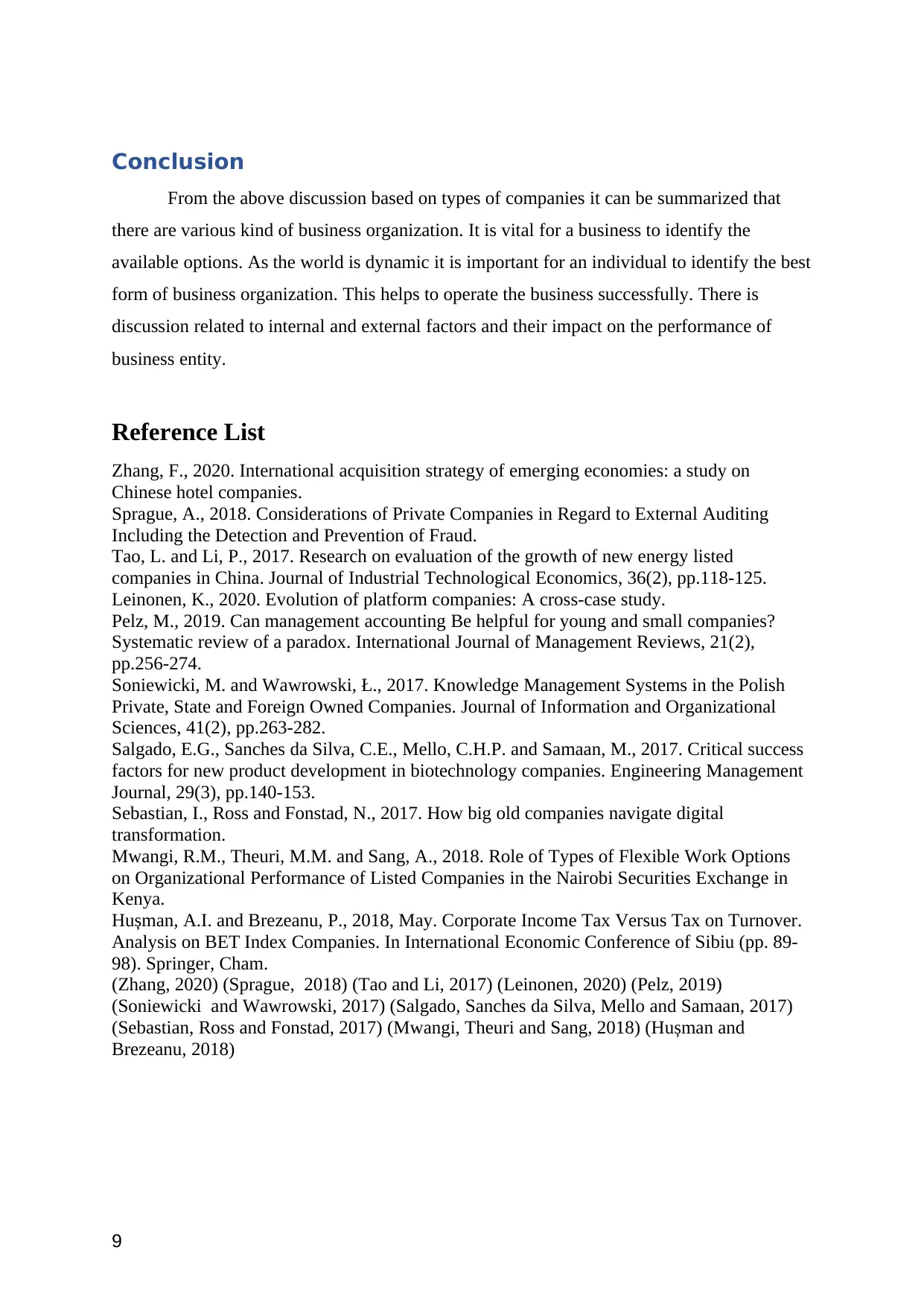
Conclusion
From the above discussion based on types of companies it can be summarized that
there are various kind of business organization. It is vital for a business to identify the
available options. As the world is dynamic it is important for an individual to identify the best
form of business organization. This helps to operate the business successfully. There is
discussion related to internal and external factors and their impact on the performance of
business entity.
Reference List
Zhang, F., 2020. International acquisition strategy of emerging economies: a study on
Chinese hotel companies.
Sprague, A., 2018. Considerations of Private Companies in Regard to External Auditing
Including the Detection and Prevention of Fraud.
Tao, L. and Li, P., 2017. Research on evaluation of the growth of new energy listed
companies in China. Journal of Industrial Technological Economics, 36(2), pp.118-125.
Leinonen, K., 2020. Evolution of platform companies: A cross-case study.
Pelz, M., 2019. Can management accounting Be helpful for young and small companies?
Systematic review of a paradox. International Journal of Management Reviews, 21(2),
pp.256-274.
Soniewicki, M. and Wawrowski, Ł., 2017. Knowledge Management Systems in the Polish
Private, State and Foreign Owned Companies. Journal of Information and Organizational
Sciences, 41(2), pp.263-282.
Salgado, E.G., Sanches da Silva, C.E., Mello, C.H.P. and Samaan, M., 2017. Critical success
factors for new product development in biotechnology companies. Engineering Management
Journal, 29(3), pp.140-153.
Sebastian, I., Ross and Fonstad, N., 2017. How big old companies navigate digital
transformation.
Mwangi, R.M., Theuri, M.M. and Sang, A., 2018. Role of Types of Flexible Work Options
on Organizational Performance of Listed Companies in the Nairobi Securities Exchange in
Kenya.
Hușman, A.I. and Brezeanu, P., 2018, May. Corporate Income Tax Versus Tax on Turnover.
Analysis on BET Index Companies. In International Economic Conference of Sibiu (pp. 89-
98). Springer, Cham.
(Zhang, 2020) (Sprague, 2018) (Tao and Li, 2017) (Leinonen, 2020) (Pelz, 2019)
(Soniewicki and Wawrowski, 2017) (Salgado, Sanches da Silva, Mello and Samaan, 2017)
(Sebastian, Ross and Fonstad, 2017) (Mwangi, Theuri and Sang, 2018) (Hușman and
Brezeanu, 2018)
9
From the above discussion based on types of companies it can be summarized that
there are various kind of business organization. It is vital for a business to identify the
available options. As the world is dynamic it is important for an individual to identify the best
form of business organization. This helps to operate the business successfully. There is
discussion related to internal and external factors and their impact on the performance of
business entity.
Reference List
Zhang, F., 2020. International acquisition strategy of emerging economies: a study on
Chinese hotel companies.
Sprague, A., 2018. Considerations of Private Companies in Regard to External Auditing
Including the Detection and Prevention of Fraud.
Tao, L. and Li, P., 2017. Research on evaluation of the growth of new energy listed
companies in China. Journal of Industrial Technological Economics, 36(2), pp.118-125.
Leinonen, K., 2020. Evolution of platform companies: A cross-case study.
Pelz, M., 2019. Can management accounting Be helpful for young and small companies?
Systematic review of a paradox. International Journal of Management Reviews, 21(2),
pp.256-274.
Soniewicki, M. and Wawrowski, Ł., 2017. Knowledge Management Systems in the Polish
Private, State and Foreign Owned Companies. Journal of Information and Organizational
Sciences, 41(2), pp.263-282.
Salgado, E.G., Sanches da Silva, C.E., Mello, C.H.P. and Samaan, M., 2017. Critical success
factors for new product development in biotechnology companies. Engineering Management
Journal, 29(3), pp.140-153.
Sebastian, I., Ross and Fonstad, N., 2017. How big old companies navigate digital
transformation.
Mwangi, R.M., Theuri, M.M. and Sang, A., 2018. Role of Types of Flexible Work Options
on Organizational Performance of Listed Companies in the Nairobi Securities Exchange in
Kenya.
Hușman, A.I. and Brezeanu, P., 2018, May. Corporate Income Tax Versus Tax on Turnover.
Analysis on BET Index Companies. In International Economic Conference of Sibiu (pp. 89-
98). Springer, Cham.
(Zhang, 2020) (Sprague, 2018) (Tao and Li, 2017) (Leinonen, 2020) (Pelz, 2019)
(Soniewicki and Wawrowski, 2017) (Salgado, Sanches da Silva, Mello and Samaan, 2017)
(Sebastian, Ross and Fonstad, 2017) (Mwangi, Theuri and Sang, 2018) (Hușman and
Brezeanu, 2018)
9
⊘ This is a preview!⊘
Do you want full access?
Subscribe today to unlock all pages.

Trusted by 1+ million students worldwide
1 out of 9
Related Documents
Your All-in-One AI-Powered Toolkit for Academic Success.
+13062052269
info@desklib.com
Available 24*7 on WhatsApp / Email
![[object Object]](/_next/static/media/star-bottom.7253800d.svg)
Unlock your academic potential
Copyright © 2020–2025 A2Z Services. All Rights Reserved. Developed and managed by ZUCOL.




